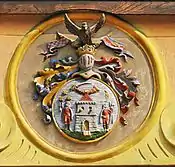Nobles of Turopolje
The nobles of Turopolje or nobles of the plain (Hungarian: túrmezei nemesek, Latin: nobiles de campo) formed a group of conditional nobles in Slavonia within the Kingdom of Hungary from the second half of the 13th century to the middle of the 19th century. They lived in a self-governing "noble peasant community" and were exempted of taxation. They were partisans of the Croatian-Hungarian Party in the 1830s and 1840s. They were named after the region of Turopolje south of Zagreb.

History
The nobles of Turopolje descended from castle warriors (nobiles iobagiones) of Zagreb County who received special privileges as a community in the second half of the 1270s.[1] Thereafter they were exempted of taxation and were entitled to elect judges to hear their legal cases.[1] Their lands were located in the territory bordered by the rivers Kupa and Sava and the Vukomerec Hills, south of Zagreb. The "sandaled nobles of Turopolje" were not "true noblemen of the realm",[1] thus the Sabor or parliament denied their right to vote at its sessions from the 1750s.[2] However, their right to send representatives to the Sabor was confirmed by the Court Chancellery of the Kingdom of Hungary in 1830.[2] Thereafter they represented the interests of the central government in Slavonia,[2][3] against the Illyrian Party which stated that Croatia was a separate realm, not part of the Kingdom of Hungary.[4]
Footnotes
- Rady 2000, p. 81.
- Feldman 2004, p. 86.
- Magaš 2008, p. 222.
- Péter 2012, p. 203.
References
- Feldman, Andrea (2004). Imbro Tkalac: Memoirs of Boyhood in Nineteenth Century Croatia. In: Naumović, Slobodan; Jovanović, Miroslav; Childhood in South East Europe: Historical Perspectives on Growing Up in the 19th and 20th Centuries. Lit Verlag. ISBN 3-8258-6439-1.
- Magaš, Branka (2008). Croatia through History: The Making of a European State. Saqi Books. ISBN 978-0-8635-6775-9
- Péter, László (2012). Hungary's Long Nineteenth Century: Constitutional and Democratic Traditions in a European Perspective (Collected Studies, Edited by Miklós Lojkó). BRILL. ISBN 978-90-04-22212-0.
- Szeberényi, Gábor (2012). "Nemesi közösségek a Szepességben és Túrmezőn a 13–14. században (Szempontok a szepesi tízlándzsások és a turopoljei nemesek párhuzamának kérdéséhez) [Noble Communities in Scepusia and Turopolje in the 13th–14th Centuries (Some Aspects of Presumed Parallels in the History of Scepusian and Turopolje Nobility)]". In Bagi, Dániel; Fedeles, Tamás; Kiss, Gergely (eds.). "Köztes-Európa vonzásában". Ünnepi tanulmányok Font Márta tiszteletére (in Hungarian). Kronosz Kiadó. pp. 439–449. ISBN 978-615-5181-69-6.CS1 maint: ref=harv (link)
- Rady, Martyn (2000). Nobility, Land and Service in Medieval Hungary. Palgrave (in association with School of Slavonic and East European Studies, University College London). ISBN 0-333-80085-0.